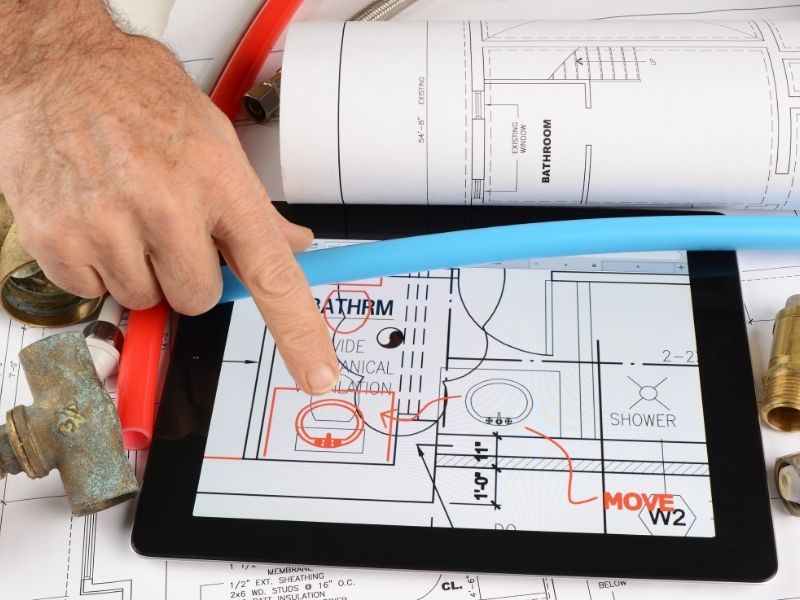A bathroom renovation or remodeling project is a rewarding experience. But it’s a huge undertaking that has a significant impact on your home. For one, improving the space that you use daily boosts its appeal and market value. However, you must educate yourself to avoid making some bad mistakes during your bathroom renovation.
As a significant investment, ensuring your bathroom renovation progresses smoothly requires a good plan. This helps you avoid wasting time, money, and effort. Therefore, it’s important that you are aware of plumbing issues that might occur. Continue reading to learn the seven tactics you need to know to avoid plumbing issues during your bathroom renovation.
Avoid Plumbing Issues During Your Bathroom Renovation • 7 Tactics You Need to Know

1. Hire the right contractor.
When looking for a contractor for the bathroom renovation project, make sure to avoid hiring the wrong one. Remember that the bathroom has a specific use, so you need to work with a specialist to ensure that all the essential elements work optimally. During the selection process, you should check out the portfolios and references. Today, some companies exclusively tackle bathrooms. These are usually the best option since they’re capable of handling various problems that might arise along the way.
If you’re eager to learn more about renovation services, checking out reliable providers of bathroom renovation Oakville and others would greatly help.
2. Keep the plumbing intact.
Avoid overhauling the plumbing system during a bathroom remodeling project unless it’s part of your plan. Doing so will surely add up to your overall expenses. This being said, it’s best to add new sinks, toilets, showers, and tubs in their original locations.
3. Immediate elimination of mold.
The moist environment of bathrooms makes them prone to mold growth, which can be a health hazard. Before the renovation project starts, you should inspect for black spots on the drywall and walls that appear wet since these are indications of mold.
Immediately removing mold that starts to develop in your bathroom is crucial since prevents it from spreading around your home. In most cases, deep mold remediation by a professional is necessary before the construction.
4. Select a sink first.
Some homeowners often get excited about the project that they buy fixtures in the incorrect order. One of the common mistakes is buying a cabinet and installing it before choosing a sink. Also, if you don’t buy the bathroom sink first, it might have the wrong size or be in the wrong position when considering the location of the pipes.
In both scenarios, it requires cutting holes in your cabinet for the sink to work. Choosing a sink first ensures a better connection with the pipe without making unnecessary modifications to the new cabinetry.
5. Match the pipes.
The pipes play a crucial role during the remodeling project. The pipes must match accurately to ensure seamless functioning of the piping system. Mismatching the lines can leak and even corrode. The pipes should also fit and be compatible with the bathroom fixtures, or the water pressure will be too low.
6. Always take measurements.
Always remember that not all toilets are equal. Most people tend to buy a toilet, assuming that any type will perfectly fit and function in their space. Sadly, if you don’t have accurate measurements, you might end up with fitting issues.
When renovating the bathroom, it’s important to measure everything since you never know if a fixture will fit perfectly. You don’t want to end up with a tilting toilet.
Measure the rough-in or the distance between the pipe outlet and the wall behind the toilet. Determine the measurements of your existing toilet and double-check if it matches with the new replacement you’re considering.
7. Venting of the sink.
As mentioned, you should handle the plumbing system in your bathroom carefully. Avoid taking shortcuts with the plumbing sbecause it can put your home at risk.
The drain should have proper venting when adding a new sink. When the sink doesn’t have a sound vent system, your bathroom will be exposed to various elements, such as mold, pests, and even sewage gas. Proper venting of the sink will protect your home from potentially dangerous scenarios.
Sloping of the shower.
Proper sloping of the shower will prevent water from pooling in the corners, increasing the risk of mold and mildew growth. The adequate slope will allow the water to flow towards the drain.
In conclusion.
If you’re planning a bathroom renovation or remodeling project soon, proper planning is important to ensure you get the space you love while boosting the value of your home. Remember that mistakes are costly, so use these tips to avoid them.
With proper planning and learning about the common plumbing mistakes, you may successfully create a bathroom that’s both appealing and functional. If you have any questions or suggestions, we always love to hear from you in the comments below. Also below are links to more fantastic articles about ALL things DESIGN for your home or business.
Images Courtesy of Canva.
Other Posts You Might Enjoy:
4 Causes Of Mold In Homes And What You Can Do
10 Shelving inspirations For A Trendy Home





